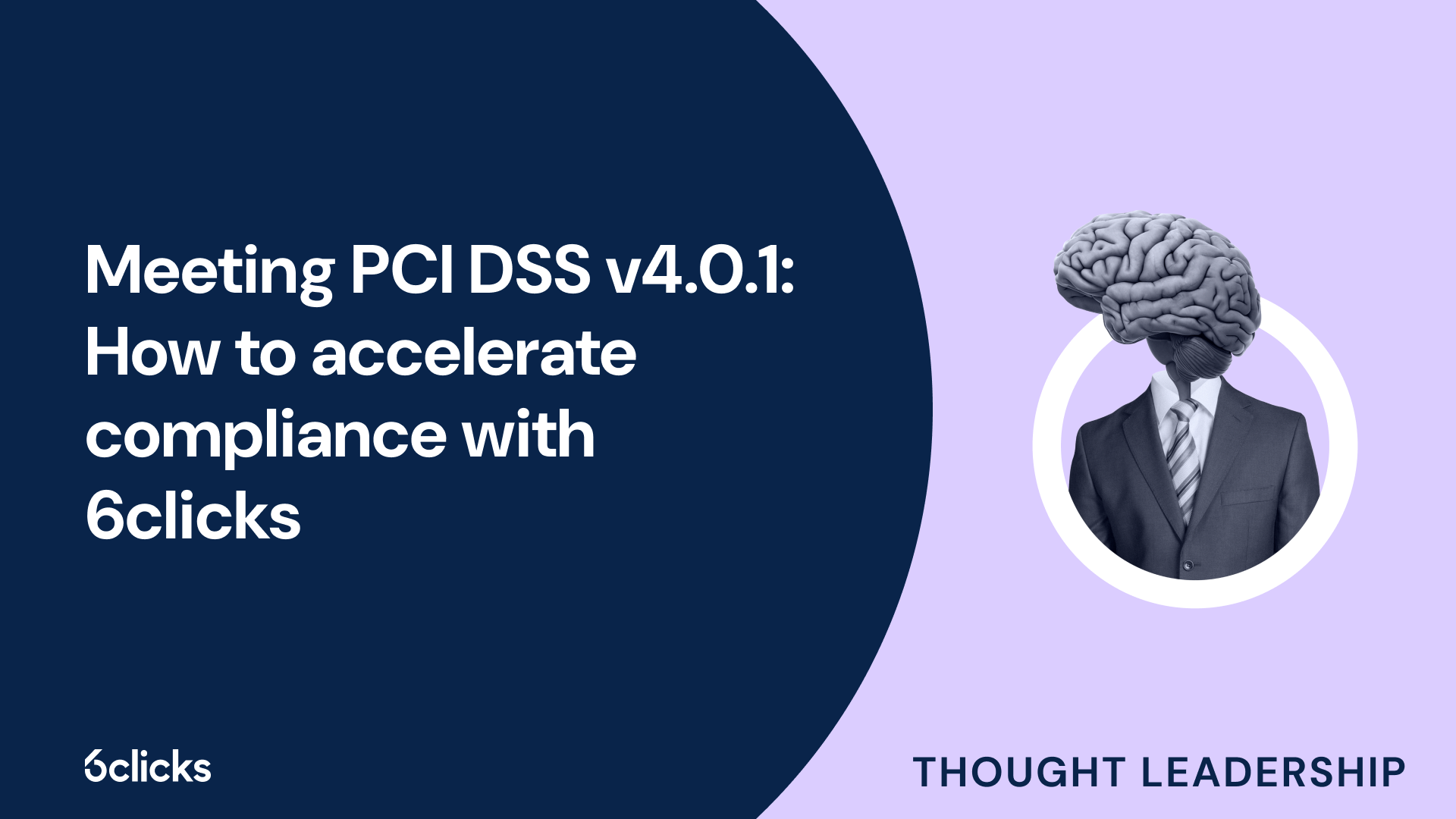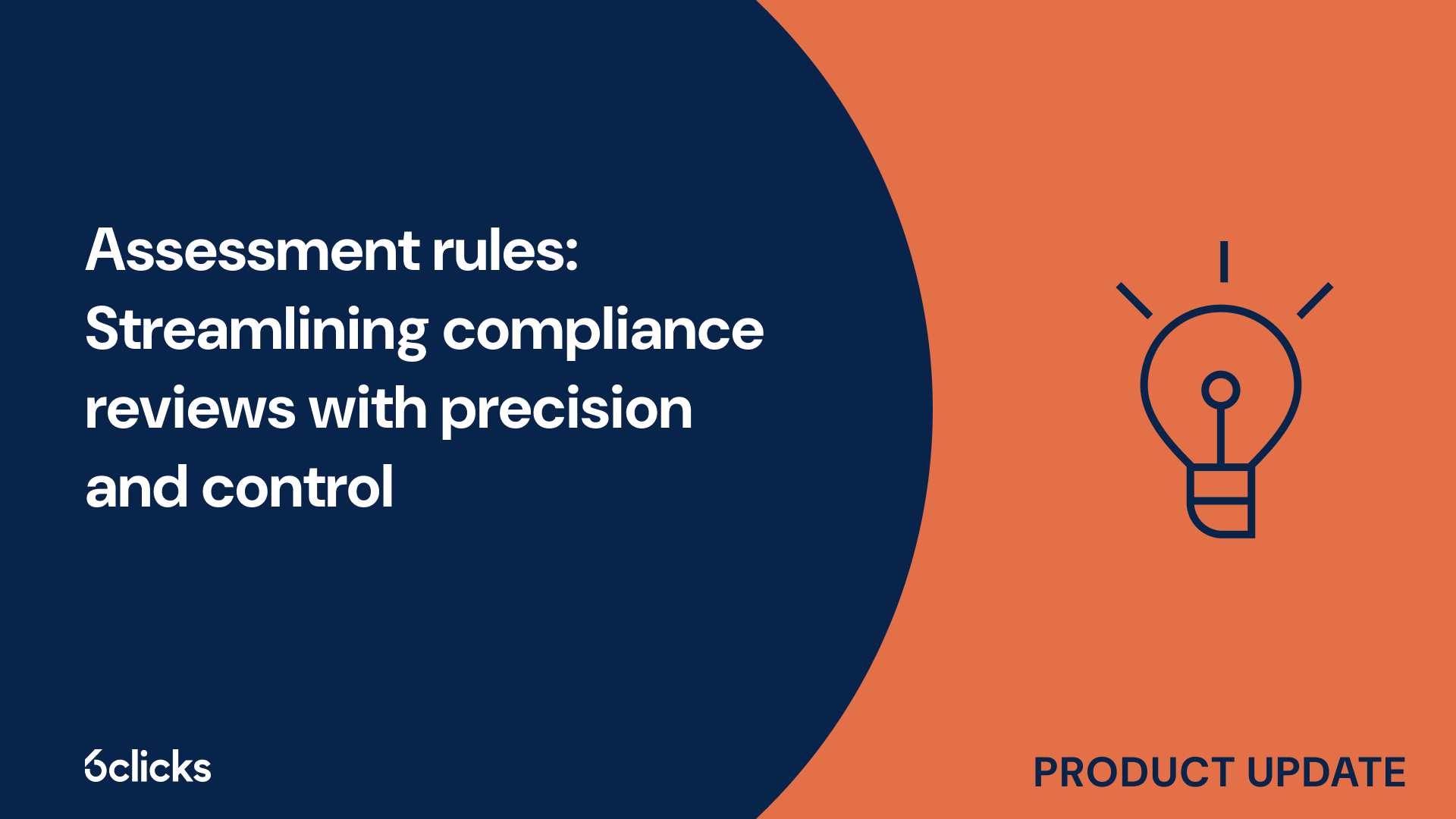The GRC buyer’s guide for 2025: Building resilience with AI-powered, federated solutions
Discover the ultimate GRC buyer's guide for 2025! Uncover how AI-powered, federated solutions transform compliance and security management for industries like government, aerospace, banking, and more. Learn about centralized control, continuous compliance, and advanced cyber GRC capabilities. Download now!
-1.png?width=200&height=249&name=Group%20193%20(1)-1.png)
The GRC buyer’s guide for 2025: Building resilience with AI-powered, federated solutions
What are ISMS controls?
ISMS stands for Information Security Management System. It is a systematic approach to managing sensitive company information, ensuring its confidentiality, integrity, and availability. ISMS controls are the measures and practices put in place to protect and secure this information. These controls are designed to mitigate the risks associated with security breaches, unauthorized access, data loss, and other security incidents. ISMS controls encompass a wide range of areas, including physical security, access controls, risk management, asset management, and network security management. By implementing these controls, organizations can establish a strong security posture and ensure the ongoing confidentiality, integrity, and availability of their information assets. In this article, we will explore the various ISMS controls and discuss their importance in maintaining a robust and secure information security management system.
The need for A comprehensive understanding of ISMS controls
In today's digital landscape, information security is of paramount importance for organizations of all sizes and industries. A comprehensive understanding of Information Security Management System (ISMS) controls is indispensable when it comes to safeguarding sensitive data and ensuring compliance with regulatory requirements.
ISMS controls play a vital role in protecting valuable information assets from unauthorized access, modification, or disclosure. They encompass various security measures and processes that are implemented to mitigate security risks and protect critical business information. From access controls to risk assessments, cryptographic controls to physical security, ISMS controls provide a holistic and systematic approach to information security.
Having a comprehensive understanding of ISMS controls enables organizations to effectively address security risks and vulnerabilities. It allows them to develop security policies and requirements that align with international standards and best practices. This knowledge also facilitates the identification and management of security incidents and breaches, ensuring a prompt response and minimizing potential damages.
Moreover, a comprehensive understanding of ISMS controls is essential for meeting regulatory requirements. Many industries have specific compliance standards, such as ISO/IEC 27001, that organizations must adhere to. ISMS controls provide a framework that helps organizations meet these requirements, undergo certification processes, and demonstrate their commitment to security and compliance.
Types of ISMS controls
ISMS controls encompass a wide range of security measures and processes that are designed to protect sensitive information and mitigate security risks. These controls can be categorized into various types, each serving a specific purpose in the overall information security management system. From access controls to physical security and from risk assessments to cryptographic controls, understanding the different types of ISMS controls is crucial for organizations to effectively safeguard their valuable information assets. By implementing these controls, organizations can ensure compliance with regulatory requirements, protect against unauthorized access or disclosure, and maintain the confidentiality, integrity, and availability of their critical business information. In the following sections, we will explore some of the key types of ISMS controls that organizations should consider in their information security management strategies.
Security policies
Security policies are an integral part of an information security management system (ISMS). They set out management's direction and support for information security within an organization. These policies provide clear guidelines and expectations for employees and stakeholders on how to protect and manage information assets effectively.
Having comprehensive security policies is crucial for any organization as they establish the framework for managing security risks and safeguarding sensitive information. They help to ensure the confidentiality, integrity, and availability of information, as well as compliance with legal, regulatory, and contractual requirements.
Developing effective security policies involves several key requirements. Firstly, policies should be aligned with organizational objectives and demonstrate senior management's commitment to information security. Secondly, they should be comprehensive, addressing all relevant aspects such as access control, incident response, and physical security. Thirdly, policies should be communicated to all employees and regularly reviewed and updated to stay current and robust.
ISO 27001 controls A5, defined in Annex A of the international standard, specifically address the development and implementation of organization-wide information security policies. These controls include establishing responsibilities for information security, allocating resources, and implementing a management framework to ensure the policies are effectively implemented.
Security requirements
Security requirements in an Information Security Management System (ISMS) involve implementing essential measures and controls to ensure the correct and secure operations of information processing facilities. These requirements encompass various aspects of security to protect sensitive information and maintain the integrity of organizational systems.
One crucial security requirement is protection from malware. Organizations must implement robust antivirus and anti-malware solutions to detect and prevent malicious software from compromising systems. Regular updates and patches should be applied to ensure the effectiveness of these protective measures.
Backup procedures are also essential in an ISMS. Regular backups of critical data should be performed to mitigate the risk of data loss or corruption. These backups should be securely stored and periodically tested to guarantee the ability to restore information when needed.
Logging and monitoring play a vital role in maintaining a secure environment. Organizations should implement logging mechanisms to track and record activities within information systems. Regular monitoring of logs enables the detection of suspicious activities or security breaches, allowing for timely response and mitigation.
Control of operational software is another important security requirement. Organizations should establish procedures to ensure that only authorized and verified software is installed on systems. Regular software updates should also be performed to address vulnerabilities and enhance security.
Finally, technical vulnerability management is crucial to identify and mitigate potential weaknesses in information systems. Regular vulnerability assessments and penetration tests should be conducted to identify and remediate vulnerabilities promptly.
Annex A
Annex A of ISO 27001 outlines a comprehensive set of security controls that organizations can implement to manage their information security risks effectively. These controls are divided into 14 categories, each addressing specific aspects of information security:
- Information Security Policies: Organizations should establish and maintain a set of information security policies that define the approach to managing security risks.
- Organization of Information Security: This category focuses on assigning and defining security roles and responsibilities within the organization.
- 3. Human Resource Security: Controls in this category ensure that employees and contractors are aware of their information security responsibilities and undergo proper screening before being granted access to sensitive information.
- Asset Management: These controls ensure that assets within the organization, such as information, technology resources, and physical infrastructure, are properly identified, classified, and protected.
- Access Control: Access control measures aim to prevent unauthorized access to information and resources by implementing user authentication, authorization processes, and user access management.
- Cryptography: Controls in this category focus on the proper use and management of cryptographic techniques to protect the confidentiality, integrity, and authenticity of sensitive information.
- Physical and Environmental Security: Controls within this category address the protection of physical assets, such as facilities, equipment, and media, as well as environmental hazards that may impact information security.
- Operations Security: These controls ensure secure operational processes, such as change management, incident management, and business continuity planning.
- Communications Security: Measures within this category focus on securing information during transmission, including network security management and protecting against unauthorized disclosure.
- System Acquisition, Development, and Maintenance: These controls guide the secure development, testing, and maintenance of information systems throughout their lifecycle.
- Supplier Relationships: Controls within this category aim to ensure that suppliers and third-party organizations meet appropriate information security requirements.
- Information Security Incident Management: Controls in this category address the detection, reporting, and response to security incidents, including the establishment of incident management procedures.
- Information Security Continuity: Measures within this category aim to ensure the organization's ability to continue critical operations during and after disruptive events.
- Compliance: Controls in this category focus on adherence to laws, regulations, contractual obligations, and internal policies to continuously monitor and achieve compliance.
Organizations should carefully analyze their specific risk profile through comprehensive risk assessments and select the applicable controls from Annex A. By considering their unique context, these organizations can appropriately prioritize their security investments and ensure the effectiveness and efficiency of their information security management systems.
Security controls
Security controls are an essential component of an Information Security Management System (ISMS) and play a vital role in safeguarding sensitive information and mitigating potential risks. ISMS controls are categorized into different domains, each serving specific objectives.
- Information Security Policies: These controls establish a framework for managing security risks by defining the organization's approach to information security.
- Organization of Information Security: Controls in this category focus on assigning roles and responsibilities, ensuring that security responsibilities are clearly defined and implemented within the organization.
- Human Resource Security: Controls here ensure that employees and contractors are aware of their security responsibilities and undergo proper screening before accessing sensitive information, minimizing the risk of insider threats.
- Physical and Environmental Security: These controls aim to protect physical assets, facilities, and equipment, as well as address potential environmental hazards that may impact information security.
- Communications and Operations Management: Measures within this domain focus on securing information during transmission, network security management, and incident management to ensure the secure operation of organizational processes.
- Access Control: Controls in this category prevent unauthorized access to information and resources by implementing authentication, authorization processes, and user access management.
- Information System Acquisition, Development, and Maintenance: These controls guide the secure development, testing, and maintenance of information systems throughout their lifecycle.
- Information Security and Incident Management: Controls in this domain address the detection, reporting, and response to security incidents, establishing incident management procedures.
- Business Continuity Management: Measures here ensure an organization's ability to continue critical operations during and after disruptive events, implementing plans for quick recovery.
- Compliance: Controls in this category focus on adherence to laws, regulations, contractual obligations, and internal policies to continuously monitor and achieve compliance.
- Cryptography: Controls in this domain focus on the proper use and management of cryptographic techniques to protect the confidentiality, integrity, and authenticity of sensitive information.
- Supplier Relationships: Controls within this category aim to ensure that suppliers and third-party organizations meet appropriate information security requirements, minimizing the risk of breaches through external parties.
By implementing and maintaining these diverse ISMS controls, organizations can establish a robust security posture, proactively addressing potential risks and ensuring the confidentiality, integrity, and availability of their information assets.
Risk assessment
Risk assessment is a crucial component of an Information Security Management System (ISMS) and plays a significant role in protecting an organization's sensitive information. It is the process of identifying, assessing, and prioritizing security risks to develop effective controls and mitigation strategies.
Conducting a thorough risk assessment is essential because it helps organizations understand their assets, the potential threats they face, and the vulnerabilities that can be exploited. By pinpointing these elements, organizations can gain a comprehensive view of their security landscape and prioritize their efforts and resources effectively.
The process of conducting a risk assessment typically involves several steps. The first step is to identify and define the assets that need to be protected. This includes identifying the critical information, systems, and resources within the organization.
Next, organizations need to evaluate the potential threats and vulnerabilities that exist. Threats can come from various sources, such as hackers, disgruntled employees, or natural disasters. Vulnerabilities are weaknesses or gaps within the organization's security measures that can be exploited by threats.
Once threats and vulnerabilities are identified, organizations must assess the likelihood and impact of each risk. This involves analyzing the probability of a threat occurring and the potential consequences it may have on the organization's information and operations.
Finally, organizations need to determine the appropriate risk treatment options. This could involve implementing security controls, transferring risks through insurance, accepting the risks, or avoiding them altogether.
Security risks
Security risks are potential threats that can compromise the confidentiality, integrity, and availability of an organization's sensitive information and resources. In an Information Security Management System (ISMS), the identification and management of security risks are of paramount importance to ensure the protection of valuable assets.
Security risks can arise from both internal and external sources. Internal threats may include employees with malicious intent, careless or uninformed employees, or inadequate access controls. External threats can include hackers, cybercriminals, and natural disasters that can disrupt operations and compromise sensitive information.
The impact of security risks on an organization can be severe. Breaches and incidents can result in financial loss, damage to reputation, legal and regulatory consequences, and loss of customer trust. Organizational downtime and disruption to critical services can also result from security incidents.
To effectively manage security risks, organizations need to conduct regular risk assessments. These assessments involve identifying and evaluating potential threats, vulnerabilities, and the likelihood and impact of each risk. By assessing the risks, organizations can prioritize their efforts and allocate resources for risk treatment options such as implementing security controls, creating incident response plans, and enhancing employee awareness and training.
International standards
The ISO 27001 series consists of several international standards that support ISO 27001 and provide guidance on specific topics related to information security management. These standards help organizations implement effective controls, measure information security, manage risk, and address security in cloud environments.
ISO/IEC 27002, also known as the Code of Practice for Information Security Controls, offers guidance on implementing the controls listed in ISO 27001 Annex A. It provides detailed recommendations for organizations to establish, implement, maintain, and continually improve their information security management systems.
ISO/IEC 27004 focuses on measuring information security. It provides guidance on developing, implementing, and assessing information security metrics and establishes a framework for organizations to monitor and evaluate the effectiveness of their information security management systems.
ISO/IEC 27005 is a standard specifically dedicated to information security risk management. It provides guidelines for organizations to identify, assess, and manage information security risks effectively. By following ISO/IEC 27005, organizations can enhance their risk management processes and make informed decisions regarding risk treatment.
ISO/IEC 27017 addresses information security in cloud environments. It provides guidelines and objectives for both cloud service providers and cloud service customers to ensure the secure handling of information in the cloud. This standard helps organizations mitigate the unique risks associated with cloud computing.
ISO/IEC 27018 focuses on the protection of privacy in cloud environments. It offers guidelines for cloud service providers to implement appropriate measures and controls to protect personal data in the cloud. Organizations can use ISO/IEC 27018 to ensure compliance with legal requirements and establish trust with their customers.
By adhering to these international standards in the ISO 27001 series, organizations can strengthen their information security management systems, manage risk effectively, and address the specific challenges posed by cloud environments, ultimately ensuring the confidentiality, integrity, and availability of their information.
Security incidents
Security incidents are a critical aspect of an Information Security Management System (ISMS), and effective incident management controls play a crucial role in protecting an organization's sensitive information. These controls establish the framework for handling security incidents promptly and efficiently.
Roles and responsibilities are a fundamental component of incident management controls. Clear roles and responsibilities outline the tasks and actions individuals or teams need to perform when a security incident occurs. This ensures that everyone understands their roles and can act swiftly to mitigate the impact of the incident.
Reporting is an essential part of incident management controls. It involves promptly notifying the relevant individuals or teams when a security incident is detected. Timely reporting allows for a swift response and helps prevent further damage or loss.
Assessing security incidents is vital to determine their impact and severity. Thorough assessment enables organizations to prioritize response actions based on the level of risk and potential harm caused by the incident.
Responding to security incidents involves taking appropriate actions to contain, eradicate, and recover from the incident. Incident management controls guide organizations on the necessary steps to mitigate the incident's effects and prevent its recurrence.
Learning from security incidents is crucial for continuous improvement. Incident management controls facilitate the analysis and documentation of incidents, enabling organizations to identify trends, vulnerabilities, and weak points in their security protocols. This knowledge can then be used to enhance preventive measures and strengthen the overall security posture.
To ensure a comprehensive approach, organizations should maintain an incident and corrective action log. This log captures all incidents, including their details, actions taken, and remediation measures implemented. It serves as a valuable reference for future incident management and helps organizations track their efforts to address vulnerabilities and prevent similar incidents.
Management review
Management review is a critical component of an organization's information security management system (ISMS) controls. It serves the purpose of evaluating and assessing the effectiveness of the security management system and ensuring its alignment with business objectives. The process of management review involves a systematic examination of the security measures, controls, and policies implemented within an organization.
Management review plays a crucial role in the overall effectiveness of an organization's security management system. It provides an opportunity for top management to review the status of the ISMS controls, identify potential risks or issues, and make informed decisions to improve the overall security posture. By regularly reviewing the ISMS controls, organizations can ensure that they remain relevant, up-to-date, and aligned with changing security requirements, business needs, and international standards.
Key activities and responsibilities involved in conducting management review meetings include:
- Reviewing the performance and effectiveness of the security management system.
- Assessing the organization's compliance with security policies, requirements, and legal obligations.
- Analyzing the results of risk assessments, security incident reports, and internal audits.
- Discussing any security breaches, incidents, or non-conformance issues.
- Identifying areas for improvement and setting future objectives for the ISMS controls.
- Allocating necessary resources for implementing security measures and addressing identified risks.
- Making decisions on potential improvements to enhance the security management system.
- Ensuring continual improvement by setting action plans and monitoring their progress.
Security breaches
Security breaches are incidents that compromise the confidentiality, integrity, or availability of an organization's information or information systems. In the context of an Information Security Management System (ISMS), security breaches refer to the unauthorized access, disclosure, alteration, or destruction of sensitive data or assets.
Security breaches can have a significant impact on organizations. They can result in financial losses, reputational damage, legal and regulatory non-compliance, and loss of customer trust. Organizations may also face penalties, lawsuits, and the potential loss of business opportunities if they fail to address security breaches effectively.
Common types of security breaches that organizations may encounter include:
- Data breaches: Unauthorized access or disclosure of sensitive data, such as personal information, financial records, or intellectual property.
- Malware attacks: Attempts to infect systems with malicious software, such as viruses, worms, or ransomware, which can compromise data and disrupt operations.
- Insider threats: Misuse or abuse of privileges by trusted insiders, including employees, contractors, or business partners, resulting in unauthorized access or unauthorized disclosure of information.
- Social engineering: Manipulation or deception techniques used to trick individuals into revealing sensitive information, such as passwords or confidential data.
To prevent and respond to security breaches effectively, organizations should implement several best practices and controls. These include:
- Implementing access controls: Restricting access to sensitive information and systems based on user roles and responsibilities, implementing strong authentication mechanisms, and regularly reviewing access privileges.
- Educating employees: Providing training on security awareness, safe computing practices, and recognizing and reporting potential security incidents.
- Regularly patching systems and applications: Keeping systems up-to-date with security patches and fixes to address vulnerabilities that may be exploited by attackers.
- Performing security monitoring and incident response: Implementing systems and processes to detect and respond to security incidents promptly, minimizing the impact of breaches and preventing further damage.
- Conducting regular risk assessments: Identifying potential vulnerabilities and risks, and implementing appropriate safeguards and measures to mitigate them.
Addressing security breaches is imperative for organizations to protect their sensitive data, comply with regulations, maintain customer trust, and safeguard their reputation in an increasingly connected and digital world. By adopting best practices and implementing robust security controls, organizations can minimize the likelihood and impact of security breaches, ensuring the integrity, confidentiality, and availability of their information assets.
Security roles
Security roles play a crucial role in ensuring the effective implementation and running of an Information Security Management System (ISMS) within an organization. These roles are responsible for various tasks related to the organization of information security.
One of the key responsibilities of security roles is to develop and implement security policies and processes. This includes conducting risk assessments, identifying security controls, and defining security objectives. By assigning specific individuals or teams to these roles, organizations can ensure that there is a dedicated focus on addressing security risks and protecting sensitive information.
Security roles also play a vital part in establishing and maintaining the ISMS. They are responsible for coordinating and integrating security activities across different departments or functions within the organization. This involves regular communication, collaboration, and training to ensure that everyone is aware of their security responsibilities.
Assigning security roles is important because it helps create a clear structure and accountability for managing security within the organization. By designating specific individuals or teams to handle security-related tasks, organizations can streamline decision-making processes and ensure that security measures are effectively implemented and monitored.
Processing facilities
Processing facilities are an integral part of Information Security Management Systems (ISMS) controls, as they have a significant impact on the overall security of an organization's information systems. These facilities encompass the physical locations where data is processed, stored, and transmitted, and play a critical role in ensuring the integrity, availability, and confidentiality of information.
Firstly, processing facilities are crucial for maintaining the integrity of data. They provide a controlled environment where data can be securely processed and stored. This includes implementing access controls, ensuring proper segregation of duties, and employing secure data transmission protocols. By adhering to these requirements, organizations can minimize the risk of unauthorized modifications to data, ensuring its accuracy and reliability.
Secondly, processing facilities are essential for ensuring the availability of information systems. They provide the necessary infrastructure and resources, such as power backup systems, redundant hardware, and robust network connectivity, to ensure continuous and uninterrupted operation. By securing these facilities and implementing appropriate redundancy measures, organizations can mitigate the risk of system downtime or disruptions, ensuring that critical information remains accessible to authorized users.
Lastly, processing facilities are instrumental in safeguarding the confidentiality of sensitive data. They implement physical security measures such as surveillance, access control systems, and secure storage facilities to prevent unauthorized access to information. Additionally, they create controlled environments that minimize the risk of data breaches or unauthorized disclosures. These facilities ensure that only authorized personnel have access to sensitive information, protecting it from potential threats.







